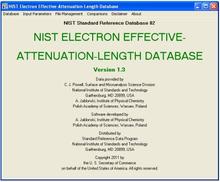NIST Standard Reference Database 82
NIST Electron Effective-Attenuation-Length Database
Version 1.3
Last Update to Data Content: 2009 DOI: http://dx.doi.org/10.18434/T4MK5P
This database provides values of electron effective attenuation lengths (EALs) in solid elements and compounds at selected electron energies between 50 eV and 2,000 eV. The database was designed mainly to provide EALs (to account for effects of elastic-electron scattering) for applications in surface analysis by Auger-electron spectroscopy (AES) and X-ray photoelectron spectroscopy (XPS).
For these applications, EALs are needed mainly for measurements of the thicknesses of overlayer films and to a much lesser extent for measurements of the depths of thin marker layers. The EAL database incorporates needed transport mean free paths (TMFPs) and inelastic mean free paths from two other NIST database (SRD 64 and SRD 71). EALs are then calculated using an algorithm based on electron transport theory for measurement conditions specified by the user. Version 1.1 of SRD 82 uses TMFPs from Version 3.1 of SRD 64, whereas Version 1.0 of SRD 82 used TMFPs from Version 2.0 of SRD 64. The new TMFPs are believed more reliable than those used earlier. Version 1.2 of SRD 82 corrects bugs in software used to calculate the mean escape depth and the effective attenuation length for quantitative analysis.
The database supplies "local" EALs (derived from the slope of the emission depth distribution function (DDF) at a specified depth) and "practical" EALs suitable for measurements of overlayer-film thicknesses or depths of thin marker layers. For the latter applications, the database provides a table of practical EALs for a user-specified range of thicknesses or depths. These EALs are plotted as a function of thickness or depth, and an average value shown for a user-selected thickness or depth. An average practical EAL (for thickness measurements) can then be utilized as the "lambda parameter" to obtain overlayer-film thicknesses from simple equations in which the effects of elastic-electron scattering are neglected. A single average practical EAL can generally be employed for electron emission angles up to about 60o. Files with computed EALs can be created and used to prepare plots in which EALs for different conditions or for different materials can be compared. The EAL files and the plots can be printed and stored for use in other applications.
The database also supplies values of other parameters for an infinitely thick material: the electron mean escape depth, the correction parameters Qx and beta-eff for determination of surface composition by XPS, and the correction parameter QA for determination of surface composition by AES. In addition, a user can obtain the DDF for a specified material and measurement configuration, and the ratio of this DDF to the DDF found with elastic-electron scattering neglected.
System Requirements: Personal computer operating on Windows 2000, Windows ME, NT, Windows XP, Windows Vista or Windows 7, and hard disc space of at least 7.3 MB.
Price: No Charge
Click here to download.
Please click here to view the PDF version of the Users' Guide.
NIST Standard Reference Database 82
For more information please contact:
SRD Customer Support, 100 Bureau Dr., Stop 6410, Gaithersburg, MD 20899-6410; 1(844) 374-0183 (Toll Free) e-mail data [at] nist.gov (data[at]nist[dot]gov)
The scientific contact for the database is:
Cedric Powell Surface and Microanalysis Science Division (837) National Institute and Standard and Technology Gaithersburg MD 20874-8370 Phone: (301) 975-2534 email:cedric.powell [at] nist.gov (cedric[dot]powell[at]nist[dot]gov)

Keywords: Auger electron spectroscopy,electron effective attenuation length,depth distribution function, surface analysis, x-ray photoelectron spectroscopy.

